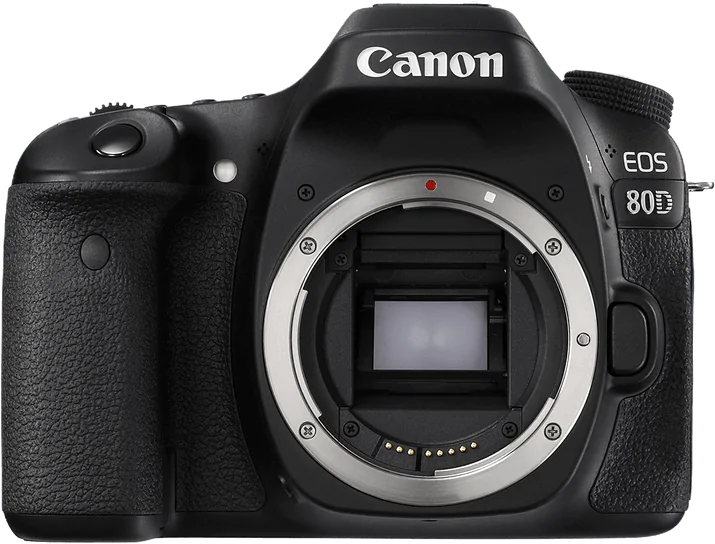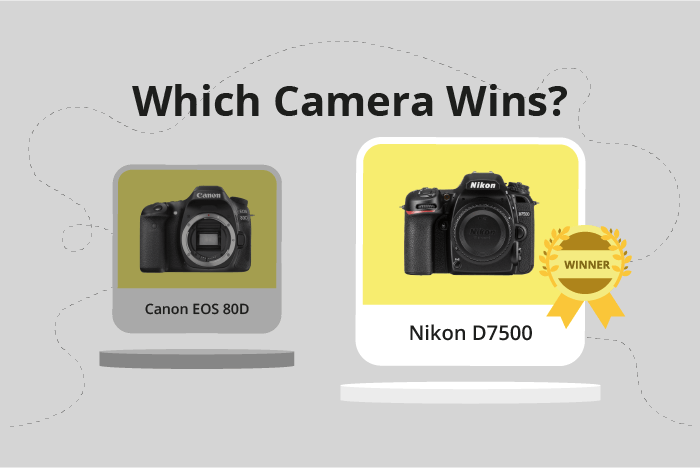Canon EOS 80D vs Nikon D7500 Comparison
Canon EOS 80D

Nikon D7500

The Nikon D7500 takes the lead with a score of 70/100, while the Canon EOS 80D trails behind at 64/100. Both cameras share similarities as DSLRs, having a similar launch price ($1250 for Nikon D7500 and $1200 for Canon EOS 80D), and comparable sizes and weights. The Nikon D7500 excels with its slightly smaller dimensions (136 x 104 x 73mm) and lighter weight (720g) compared to the Canon EOS 80D (139 x 105 x 79mm and 730g).
Despite the Canon EOS 80D’s lower score, it was released in 2016, a year earlier than the Nikon D7500, which may appeal to some users. Ultimately, the Nikon D7500 stands out as the better camera based on our ranking, but the Canon EOS 80D still offers competitive features and performance.
Canon EOS 80D vs Nikon D7500 Overview and Optics
The Nikon D7500 wins the optics comparison with a score of 68/100, while the Canon EOS 80D scores 63/100. Both cameras share some common specifications, such as the 24.2 and 20.9 megapixels, CMOS sensor type, APS-C sensor size, and the absence of image stabilization. They also have different lens mounts, with the Canon using EF-S and the Nikon using F DX.
The Nikon D7500 outperforms the Canon EOS 80D in several areas. It has a higher shooting speed of 8 frames per second, compared to the Canon’s 7. The Nikon’s Expeed 5 processor is more advanced than the Canon’s Digic 6, contributing to the camera’s overall performance. Furthermore, the Nikon D7500 has a higher DXOMARK score for the sensor at 86, compared to the Canon EOS 80D’s score of 79. This indicates that the Nikon D7500 offers better image quality and low-light performance.
On the other hand, the Canon EOS 80D has a higher megapixel count of 24.2 compared to the Nikon D7500’s 20.9. This means that the Canon EOS 80D can capture more detail in images, although the difference may not be significant for most users.
Taking these factors into account, the Nikon D7500 emerges as the superior camera in terms of optics. Its higher shooting speed, advanced processor, and better sensor performance give it an edge over the Canon EOS 80D. However, the Canon EOS 80D’s higher megapixel count may appeal to those who prioritize image detail. Ultimately, the choice between these two cameras will depend on individual preferences and specific photography needs.
Canon EOS 80D vs Nikon D7500 Video Performance
The Canon EOS 80D and the Nikon D7500 both have a video score of 70 out of 100. This indicates that they are equal in terms of video capabilities. Both cameras have time-lapse functionality built in, which is a useful feature for capturing changes over time.
The Nikon D7500 outperforms the Canon EOS 80D in terms of video resolution, as it has a maximum video resolution of 4K (3840 x 2160). This means that the D7500 can capture videos with higher clarity and detail compared to the EOS 80D, which has a maximum video resolution of Full HD (1920 x 1080). However, the Canon EOS 80D has a higher maximum video frame rate of 60fps, compared to the Nikon D7500’s 30fps. This allows the EOS 80D to capture smoother and more fluid motion in fast-moving scenes.
In terms of video capabilities, the Nikon D7500 has an advantage due to its higher video resolution. This allows users to create more detailed and visually impressive videos. On the other hand, the Canon EOS 80D is better suited for capturing fast action with its higher frame rate, which can be useful for sports and wildlife videography.
Based on these differences, it is clear that each camera has its own strengths and weaknesses when it comes to video capabilities. The Nikon D7500 is the better choice for those who prioritize high-resolution videos, while the Canon EOS 80D may be more appealing to those who need to capture fast-moving subjects. Ultimately, the decision will depend on the user’s specific needs and preferences.
Canon EOS 80D vs Nikon D7500 Features and Benefits
The Nikon D7500 emerges as the winner with a feature score of 83/100, while the Canon EOS 80D trails behind at 70/100. Both cameras share some common specifications, such as a touchscreen, flip screen, WIFI connectivity, and the absence of GPS. However, the Nikon D7500 surpasses the Canon EOS 80D in certain aspects, making it a superior choice.
The Nikon D7500 boasts a larger screen size of 3.2 inches, compared to the Canon EOS 80D’s 3-inch screen. Although the Canon EOS 80D has a higher screen resolution of 1,040,000 dots, the difference is minimal when compared to the Nikon D7500’s 922,000 dots. The most notable advantage of the Nikon D7500 is its Bluetooth connectivity, which the Canon EOS 80D lacks. This feature allows for seamless file transfer and remote control capabilities.
The Canon EOS 80D does not outperform the Nikon D7500 in any significant way. Both cameras offer similar features, with the Nikon D7500 having a slight edge in terms of screen size and connectivity options.
Based on these comparisons, the Nikon D7500 is the clear winner due to its larger screen size and Bluetooth connectivity. While the Canon EOS 80D is a competent camera, it does not offer any specific advantages over the Nikon D7500. Therefore, the Nikon D7500 is the better choice for those seeking a camera with advanced features and optimal performance.
Canon EOS 80D vs Nikon D7500 Storage and Battery
The Canon EOS 80D and Nikon D7500 both have a storage and battery score of 43/100. They share similarities in their storage capabilities, with each having one memory card slot and accepting SD, SDHC, and SDXC cards. Both cameras lack USB charging functionality.
The Canon EOS 80D has a slight edge in battery life, providing 960 shots per charge with its LP-E6N battery, compared to the Nikon D7500’s 950 shots with its EN-EL15a battery. This difference of 10 shots may not be significant, but it does give the EOS 80D a small advantage in terms of battery performance.
On the other hand, the Nikon D7500 is UHS-I compatible, which allows for faster data transfer rates when using compatible memory cards. This feature may be beneficial for photographers who require quick data transfer for their work.
Ultimately, both cameras have similar storage and battery capabilities, with the Canon EOS 80D having a slight advantage in battery life and the Nikon D7500 offering faster data transfer rates with UHS-I compatibility. Users should consider their specific needs when choosing between these two cameras.
Alternatives to the Canon EOS 80D and Nikon D7500
Are you still undecided about which camera is right for you? Have a look at these popular comparisons that feature the Canon EOS 80D or the Nikon D7500:

